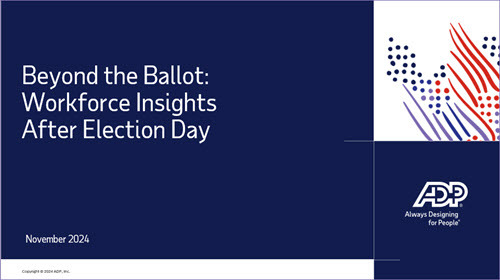Navigating Upcoming Regulatory and Policy Changes: Key Insights for Businesses

As businesses look to the future, staying informed about potential shifts in federal and state policies that could reshape operational landscapes is crucial. The recent election outcomes may result in significant legislative and regulatory changes, and companies must remain agile to navigate these changes adeptly.
One major development, preceding the recent election results, stems from the Supreme Court ruling in the Loper Bright case, which will impact federal agency rulemaking. Based on the prior Chevron doctrine, traditionally, courts deferred to federal agencies when determining whether a proposed rule was within an agency's statutory authority. After the Loper Bright decision, courts must exercise independent judgment in reviewing agency rules. This change means that courts may now take a more active role in assessing regulations, regardless of the prevailing administration, presenting both challenges and opportunities for those engaged in regulatory advocacy.
Potential policy shifts and business implications
The incoming Trump administration appears poised to focus on extending and possibly expanding provisions of the Tax Cuts and Jobs Act (TCJA) of 2017. This, together with other campaign proposals made by President-elect Trump, could lead to extensions of and modifications to business tax rates and individual tax provisions, particularly as key elements of the TCJA are set to expire in 2025. Companies should prepare for potential adjustments in:
- The 20% deduction for qualified pass-through business income
- Individual and corporate tax rates
- The standard deduction
Additionally, businesses should remain vigilant about prospective new tariffs on goods imported to the U.S. and potential changes to the taxation of overtime pay and tip income.
Launch this on-demand webcast anytime: Beyond the Ballot: Workforce Insights After Election Day
Health care policy considerations
On the healthcare front, the new administration may seek to amend the Affordable Care Act (ACA) although the exact nature of any such changes remains speculative at this time. Changes could include, among other things:
- Expanding health savings accounts (HSAs) and health reimbursement arrangements (HRAs)
- Promoting telehealth services
- Enhancing transparency in healthcare pricing
Organizations should brace for these potential healthcare reforms and evaluate new coverage options.
"Key policy changes may include expanded more flexible rules for HRAs including Individual Coverage HRAs which allow employers to contribute tax refunds for employees to purchase individual health plans," said Dan Lewis, VP, Compliance Programs and Government Affairs, ADP.
State-level changes impacting operations
Voters in Alaska and Missouri passed ballot initiatives to increase their state minimum wage rates. Alaska, Missouri, and Nebraska enacted measures to establish paid sick leave mandates. As these changes take effect over the coming years, businesses operating in these states must revise their payroll and benefits policies accordingly. Staying updated on state-specific requirements will be critical to ensure compliance and foster positive employee relations.
While all eyes were on the results of the federal election, voters in some states were asked to weigh in on key ballot initiatives, specifically in the areas of minimum wage and paid sick leave.
Helena Almeida, VP, Managing Counsel, ADP
Labor laws
With new leadership anticipated at federal agencies such as the Department of Labor (DOL), the Equal Employment Opportunity Commission (EEOC), and the Occupational Safety and Health Administration (OSHA), businesses should expect changes in workplace laws and regulations. These developments may impact areas including pay equity, workplace diversity, and labor relations. It's essential for companies to keep an eye on these shifts and adjust their policies to meet evolving standards.
Key regulatory updates: Overtime pay and worker classification
The DOL is poised for significant changes, especially with the 2024 federal overtime rule. In general, the Fair Labor Standards Act (FLSA) requires employers to pay non-exempt employees' overtime for hours worked beyond 40 per week. In April 2024, the Biden administration issued a rule raising the salary threshold for exemptions from overtime requirements, potentially extending overtime eligibility to over four million workers. However, this rule has already faced legal hurdles. On November 15, 2024, a Texas federal court struck down a U.S. DOL rule that raised the minimum salary required to be paid to most employees classified as exempt from overtime and minimum wage requirements under the FLSA.
As for worker classification, during the Biden administration the DOL published a final rule that re-introduced an Obama-era test for determining which workers are employees and which are independent contractors. In his first term, President Trump favored an "economic reality" test, for businesses to determine whether to classify workers as independent contractors. This area is also likely to see additional legal challenges and modifications as the new administration takes shape.
Looking ahead: EEO-1 reporting and future considerations
The regulatory environment could also see significant changes affecting the EEOC. Following the Obama administration's push for pay data submission requirements aimed at closing pay gaps—repealed during Trump's first term—the EEOC was set to reinstate these requirements in 2025. However, as with many initiatives, it may encounter legal challenges and potential rollback under future administrations, particularly influenced by the Loper Bright ruling.
Stay up to date with changing state, federal and local legislation that affects your business and employees. Subscribe to receive our Legislation/Eye on Washington updates in your inbox.
Next steps
The shifting regulatory landscape demands that businesses stay sharp and proactive. By closely monitoring legislative, regulatory and judicial developments, businesses can ensure compliance, optimize operations, and effectively support their workforce. Preparing for these changes now will position companies for success in the evolving legal landscape.
For additional insights, launch this on-demand webcast anytime; Beyond the Ballot: Workforce Insights After Election Day.




